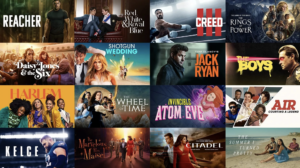Unpacking Amazon Prime Video’s move to advertising
 Today’s news that Amazon Prime Video is to include adverts from early next year, with ads to be introduced in the US, UK, Germany, and Canada in early 2024, followed by France, Italy, Spain, Mexico, and Australia later in the year, should come as no surprise.
Today’s news that Amazon Prime Video is to include adverts from early next year, with ads to be introduced in the US, UK, Germany, and Canada in early 2024, followed by France, Italy, Spain, Mexico, and Australia later in the year, should come as no surprise.
Amazon said that “to continue investing in compelling content and keep increasing that investment over a long period of time, starting in early 2024, Prime Video shows and movies will include limited advertisements”, adding that it aims to have “meaningfully fewer ads than linear TV and other streaming TV providers”.
The first question is what took it so long?
Netflix and Disney have already introduced ad-supported tiers for their own streaming services. Netflix introduced ‘Basic with Ads’ in the US last year (later to become Standard with Ads) before rolling out internationally, while Disney also introduced ads as part of its US offering in 2022 and will roll out ads internationally later this year.
For Amazon the calculation around advertising is slightly different. Video is not Amazon Prime’s main source of revenue.
“Amazon Prime Video has never been a distinct, standalone business for Amazon in the same way that Netflix is – its role for Amazon is to bolster engagement with the company’s core ecommerce business and drive sales, not to solely serve as a profitable video service,” says Matthew Bailey, principal analyst, media and entertainment and DTVE’s sister research outfit Omdia.
So, when Amazon talks about the need “to continue investing in compelling content”, it should be noted that making a return on content investment has not necessarily been the top priority hitherto – hence the streamer’s willingness to invest vast sums in shows such as its Lord of the Rings offering, Rings of Power.
“Amazon’s mammoth retail operations have been able to swallow a lot of the increased costs of commissioning and licensing TV and video, whereas the bottom line of other streamers has been more directly impacted, leading them to look to expand their revenue streams and profitability through the addition of ads,” says Bailey, who also points out that Amazon has been less susceptible to churn than other streamers because reasons to stay with the service are not necessarily directly linked to the quality of its video content.
Late convert
Amazon is therefore a late convert to ads on streaming, but it is a complete convert. The streaming service, unlike others, will transition all users onto the ad-supported version by default when it launches. With Netflix and Disney+, users are required specifically to opt for the with-ads version.
“This suggests a couple of things: First, that Amazon likely anticipates fewer cancellations from the introduction of ads than from moving all Prime subscribers to a higher cost tier. Second, it suggests that the main draw of this for Amazon is to increase the addressable audiences for its advertising business, which continues to expand and become a key driver of revenue and profitability for the company,” says Bailey.
A secondary benefit is the potential to attract subscribers to a new without-ads tier. Ads will be included in the standard offering, with subscribers given the option to upgrade to a new ad-free option for an additional US$2.99 a month in the US. Pricing for other countries will be announced at a later date. However, the main benefit to Amazon is likely to be the broader addressable audience for advertising.
The context to that is the growing importance of advertising as a revenue stream for Amazon.
“Amazon is becoming increasingly focused on becoming an advertising business, and is already the dominant power in the rapidly growing retail media space, i.e. where retailers show advertising on their ecommerce sites and apps,” says Bailey.
“The ability to tie advertising campaigns to real-world purchases – often referred to as ‘closed-loop reporting’ – is highly appealing to brands and agencies, and we are seeing retail data increasingly being used to bring this capability to other areas of media and entertainment, including video streaming services. Expanding its retail media business into Prime Video is a natural move for Amazon against this backdrop.”
Scale and reach
For Amazon, scaling its advertising business across the broadest possible video audience makes perfect sense. In addition to Amazon Prime the e-commerce giant also operates the Freevee AVOD/FAST service, which is used in part to promote Prime but which also extends the reachable advertising audience to free users. Amazon has also used Freevee to test new advertising formats such as interactive pause advertising.
Amazon’s deeper move into advertising highlights what Bailey identifies as “the trend toward hybrid monetization models in the streaming market, not just in the US but also internationally” as well as “the shift of audiences and ad spend away from traditional, linear TV towards connected TV environments”.
Regarding the latter, he points to the recent controversy that resulted in Nielsen holding back from including Amazon’s first-party viewing data in its Thursday Night Football audience measurement after broadcasters protested about the potential for Amazon effectively to mark its own homework. (Thursday Night Football, carried by Prime, already includes advertising).
While Nielsen will rely on its own panel-based data to measure Thursday Night Football, at least for now, the controversy highlights the growing power of streamers in general and Amazon in particular as a force in advertising. That is why the launch of advertising across Prime is so significant. Amazon, more than any other video streaming company, has the power to really capitalize on the shift of viewing to connected TV and build a complete advertising offering.



